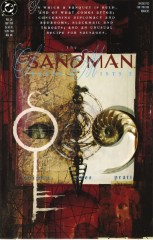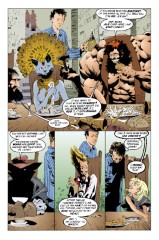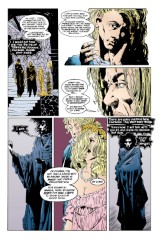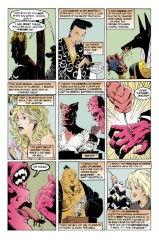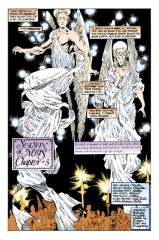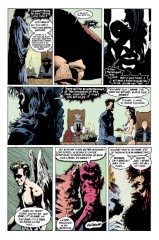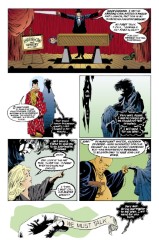Issue 26: "Season of Mists Chapter 5"
Neil Gaiman, Kelley Jones, and George Pratt
- Fifth part of storyline, Season of Mists
- Sixth story reprinted in trade paperback Season of Mists
- Audible Act II Chapter 6
In which a banquet is held,
and of what comes after;
concerning diplomacy and bedrooms, blackmail and threats;
and an unusual recipe for sausages.
Page 1#
Panel 2
The guardians of the gate are as seen before; Cluracan of Faerie is new to Sandman. The realm of Faerie has played a large role in two previous Gaiman works, Sandman #19 and Books of Magic #3.
Clúracán (with accents over the 'u' and second 'a') is a diminutive old-man fairy of Ireland, traditionally believed to inhabit wine cellars. he takes care that the beer barrels and wine casks are not left running, and for reward is always given his supper. In County Cork, the cluracan is often associated with the leprechaun, but this is because of the physical similarity and the fact that both know the whereabouts of hidden treasure.
Page 2#
Panel 2
The Lord and Lady of Faerie were seen in Sandman #19, and bear the traditional names Auberon and Titania. Nuala is new.
Page 3#
I will only note any beings who were not seen in Sandman #24. A knowledge of what has gone before is essential to the understanding of the events of this issue. The servitor here, and the female one on page 5, are dressed in nightclothes, and one infers that Dream has summoned two dreamers to act as servants at his banquet.
Panel 1
Symbolically, Mjolnir is an agent of destruction, fertility, and resurrection. It was used to hallow brides before weddings; its phallic nature is obvious here. It was also used to raise Thor's goats from the dead, and is able to shrink so that it may be hidden inside Thor's shirt as needed. Perhaps rubbing is how it is made to return to normal size. As the story goes, Loki made a bet with the dwarves in which they would have to produce three objects for the Aesir. If the gods were pleased, then Loki would lose his head. As the dwarves worked at their forges to produce the gifts, Loki came in the form of a biting fly or a bee to harass them, which introduced flaws into each gift. Thus Mjolnir had a short handle (for more, see the annotation to Sandman #24). To compensate, the dwarves further gifted Thor with a magic glove (of strength? Possibly also a belt of strength? What were the other gifts?) Although Loki lost the bet, the dwarves were not allowed to take his head, since they were not allowed to harm his neck.
Page 4#
Panel 2
The tithe was mentioned in Books of Magic #3.
Page 6#
Panels 6-7
Pain is a facet of flirtation, to a demon.
Page 7#
- This is a splash panel. Note the figures below the angels; we did not see these beings in Sandman #24, where the gods were introduced. We infer these to be more figures interested in obtaining Hell. The leftmost figure resembles the traditional depiction of wizards, with long beard and astrologically-bedecked pointy hat. He is possibly the wizard Merlin, of the Arthurian cycle. The others' identities are not readily apparent.
Page 8#
Panel 7
Sif is Thor's wife.
Page 9#
Panel 1
Gregory is the foot off to stage right.
Page 10#
Panel 1
Sawing a person in half is a common illusion practiced by stage magicians. However, Cain here has really cut Abel in twain, not just by illusion.
Panel 7
"Pooey man" is just a childish way of expressing distaste or disgust for the hapless Abel.
Panel 9
The angel Duma may be smiling at Cain's tricks in this panel.
Page 12#
Panel 1
A stooge bears the brunt of the tricks and jokes perpetrated during an act.
Page 13#
Panel 7
Note that Loki is being left essentially alone.
Page 15#
Panel 1
The warriors in the notional Ragnarok are the legendary Justice Society of America, who went there to save the world, or so they thought, in Last Days of the JSA Special #1. In the ball we can see the Hawkman, a giant (probably Surtur), and Wesley Dodds in his guise as the Sandman. We saw Wesley in the first issue of this series.
Panel 3-4
Dream's lines here are reminiscent of the lines uttered by the heroine of Sandman #18: "I am a cat, and I keep my own counsel."
Page 16#
Panel 2
It appears that Jemmy is wearing a bra, like a child playing dress-up.
Panel 3
The forces of Chaos mentioned here are unique to Gaiman.
Page 17#
Panel 2
The Lord of Order here refers to a thread that engendered two stories, in Justice League #6 and Justice League International #7, and later in a crossover between Justice League America and Justice League Europe. The agent collecting the dream essences for Order was known as the Grey Man; he rebelled and subsequently attracted the attentions of super-heroes.
Page 18#
Note the Japanese-style art. One would normally expect Susano-O-No-Mikoto, a boisterous, shouting thunder god, to be characterized more like Thor. Here, however, he appears to be the Western image of a Japanese business executive. This is an example of one of Gaiman's theses, that myths are colored by those who tell them and by those who hear them. Here, a Shinto myth changes to satisfy Western expectations. The Japanese would likely be startled to see the Floating Bridge of Heaven as a zaibatsu and the kami as sararimen, save in parody.
[N.B. Zaibatsu: a collection of allied firms. Neither a vertical nor a horizontal trust but more akin to the entire economy in microcosm. Sararimen: Company men, middle level workers who devote their careers to one company.]
Page 19#
Panel 4
Dream's brother is the prodigal Endless, who has been mentioned before, although his identity will not be revealed until Sandman Special #1. His location has not been revealed.
Page 20#
Panel 7
The Audible version makes it clear here that Matthew didn't so much take the balloon, as have it thrust upon him.
Page 24#
- Is the Key to Hell ever-changing, or is it a function of imprecise artwork? I lean toward the latter, myself.
Credits
- Originally collated and edited by Greg Morrow.
- Lance "Cogsworth" Smith lsmith@cs.umn.edu gave some info on Thor's hammer.
- Michael Bowman mbowman@andromeda.rutgers.edu researched Cluracan and also found more on Mjolnir.
- Jim W Lai jwtlai@jeeves.waterloo.edu noticed an angelic smile, gave more thought to the portrayal of the Shinto god, and observed the Key to Hell's apparent changes.
- Mike Collins, The One and Only Killans, (mcollins@isis.cs.du.edu) gave forth with great eloquence upon the origin and meaning of "pooey man".
- Richard Munn Noted the way in which Matthew obtained a balloon.
Last modified by Richard Munn on 2023-08-22 - Added some notes from Audible
[edit this page] [page history]
